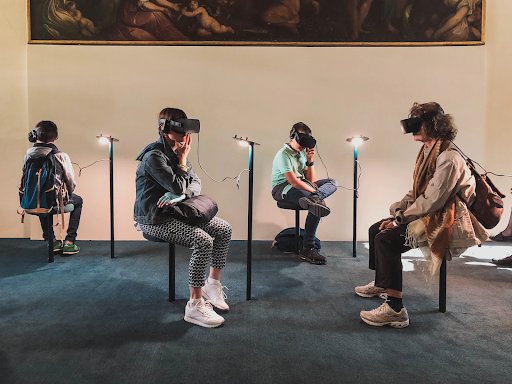Exploring the Benefits of AR and VR Solutions
Augmented Reality (AR) and Virtual Reality (VR) have become buzzwords over the past decade, captivating both consumers and businesses alike. These technologies offer immersive experiences that bridge the gap between the physical and digital worlds, opening up unprecedented opportunities in various industries. In this article, we will delve into the benefits of AR and VR solutions, examining their evolution, current applications, impact on business, and future prospects.
Understanding AR and VR Technologies
To comprehend the benefits of AR and VR solutions, it is essential to first understand the technologies themselves. Augmented Reality, as the name suggests, involves overlaying digital elements onto the physical world, enhancing our perception and interaction with our surroundings. On the other hand, Virtual Reality completely immerses users in a simulated environment, replacing their real-world experiences with computer-generated ones. Both AR and VR technologies offer unique experiences that have the potential to revolutionize various industries.
What is Augmented Reality (AR)?
At its core, Augmented Reality enhances our perception of reality by superimposing computer-generated information onto our field of view. This can be achieved through the use of specialized AR glasses, mobile devices, or even projector systems. AR can provide real-time information about the physical world, enabling users to analyze and interact with their surroundings in new and exciting ways. From navigation assistance to remote collaboration, AR has proven to be a transformative technology.

Imagine walking down a busy street in a foreign city. With AR technology, you can simply point your smartphone camera at a restaurant and instantly see reviews, ratings, and even menu recommendations floating above it. This not only saves you time and effort but also enhances your decision-making process. AR can also be used in the healthcare industry, where surgeons can wear AR glasses that display vital patient information during surgeries, improving precision and reducing the risk of errors.
Furthermore, AR has found its way into the world of education. Imagine students being able to explore ancient ruins virtually, with historical information and interactive elements popping up as they move around. This immersive learning experience not only makes education more engaging but also helps students retain information more effectively. AR has the potential to transform the way we learn, making education more accessible and interactive for all.
What is Virtual Reality (VR)?
Virtual Reality, on the other hand, transports users into a completely digital world, immersing them in experiences that feel incredibly real. By using headsets or goggles, VR replaces the user’s entire field of view with a computer-generated environment, often achieved through 3D graphics and sound. VR enables users to explore places, objects, or scenarios that may be difficult, dangerous, or even impossible to experience in reality. From gaming to training simulations, VR offers endless possibilities.

Imagine being able to explore the depths of the ocean without leaving your living room or stepping foot on a submarine. With VR, you can dive into a virtual underwater world, surrounded by colorful coral reefs and fascinating marine life. This not only provides a thrilling adventure but also serves as a powerful educational tool, allowing users to learn about marine ecosystems and conservation efforts.
VR is not limited to entertainment and education; it has also made significant strides in the field of healthcare. Surgeons can now practice complex procedures in a virtual operating room, simulating real-life scenarios without putting actual patients at risk. This training method enhances surgical skills, reduces errors, and ultimately improves patient outcomes. VR is also being used to treat patients with anxiety disorders by exposing them to virtual environments that help them confront their fears in a controlled and safe manner.
In conclusion, both AR and VR technologies have the potential to revolutionize various industries by providing unique and immersive experiences. Augmented Reality enhances our perception of reality by overlaying digital information onto the physical world, while Virtual Reality transports users into a completely digital environment. From enhancing decision-making processes and revolutionizing education to enabling realistic simulations and improving surgical training, AR and VR offer endless possibilities for innovation and advancement.
The Evolution of AR and VR
The roots of AR and VR can be traced back to decades ago, but it is only recently that these technologies have become more accessible and widely adopted. The History of AR and VR demonstrates the steady progress and refinement of these technologies, fueling their impactful applications today.
The History of AR and VR
AR and VR have their origins in various fields, including military research, aviation, and entertainment. In the 1960s, Ivan Sutherland developed the first head-mounted display, a groundbreaking milestone in the evolution of VR. Over the years, advancements in computer graphics, processing power, and display technologies propelled AR and VR forward. In the 2010s, AR gained popularity with the launch of mobile applications like Pokémon Go, while VR gained traction with the introduction of affordable headsets.
Current Trends in AR and VR
As AR and VR technologies continue to advance, they are finding their way into an array of industries. In healthcare, AR solutions are being utilized for surgical planning, rehabilitation, and mental health therapies. Educational institutions are leveraging VR to provide immersive learning experiences, taking students on virtual field trips and creating interactive simulations. The entertainment industry is constantly pushing the boundaries of AR and VR, offering captivating gaming experiences and enhancing movie-watching experiences.
Benefits of AR and VR in Different Industries
The adoption of AR and VR solutions in different sectors has yielded numerous benefits, transforming the way things are done and opening up new possibilities.
AR and VR in Healthcare
In healthcare, AR and VR technologies have the potential to revolutionize patient care and medical training. Surgeons can use AR overlays during operations, providing real-time guidance and visualization of internal structures. VR simulations offer a safe and controlled environment for medical practitioners to practice complex procedures and improve their skills. Moreover, VR has shown promising results in treating mental health conditions like phobias and PTSD, providing exposure therapy in a virtual setting.
AR and VR in Education
Education is another sector that can benefit immensely from the integration of AR and VR solutions. Virtual field trips enable students to explore historical sites, visit foreign countries, and witness important events firsthand. Complex subjects can be visualized through interactive 3D models, helping students grasp difficult concepts more effectively. AR and VR also facilitate remote learning, enabling students from different parts of the world to collaborate and learn together in virtual classrooms.
AR and VR in Entertainment
AR and VR have already made a significant impact on the entertainment industry, offering immersive experiences that transport audiences into virtual worlds. Gaming, in particular, has embraced AR and VR technologies, providing gamers with incredibly realistic and interactive experiences. From virtual escape rooms to live performances, entertainment venues are exploring innovative ways to engage and entertain audiences through the use of AR and VR.
The Impact of AR and VR on Business
The business landscape is not immune to the disruptions caused by AR and VR technologies. They have the potential to revolutionize various aspects of business operations and enhance customer experiences.
Improving Business Processes with AR and VR
AR and VR solutions can streamline and enhance business processes in several ways. In industries such as manufacturing and construction, AR can provide workers with real-time instructions and visualizations, reducing errors and improving productivity. In retail, AR applications can enable customers to virtually try on clothing or visualize furniture in their homes before making a purchase. VR can also revolutionize employee training by creating realistic simulations that allow for hands-on practice in a safe and controlled environment.
AR and VR in Marketing and Advertising
Marketing and advertising have witnessed a paradigm shift with the integration of AR and VR technologies. Brands can now offer interactive and immersive experiences to engage consumers on a deeper level. AR apps allow customers to visualize products in their own spaces before buying, while VR experiences can transport them to a simulated environment that showcases a brand’s vision and offerings. These technologies provide a new dimension for storytelling, enabling brands to connect with their target audience in a more compelling and memorable way.
Future Prospects of AR and VR
The potential of AR and VR technologies is immense, and their future prospects look promising. Numerous factors contribute to their projected growth, but challenges must also be addressed along the way.
Predicted Growth of AR and VR
The AR and VR market is expected to experience significant growth in the coming years. According to market research firm IDC, worldwide spending on AR and VR is forecasted to reach $160 billion by 2023. The increasing availability of affordable devices, advancements in content creation, and rising demand for immersive experiences across industries are all contributing factors to this growth.
Potential Challenges and Solutions
Despite the potential benefits, AR and VR technologies still face challenges that need to be overcome. Issues such as motion sickness in VR experiences, limited field of view, and dependency on external devices can impact user experiences. However, ongoing research and technological advancements are addressing these concerns, paving the way for more comfortable and immersive AR and VR solutions.
In conclusion, the benefits of AR and VR solutions are far-reaching and have the potential to transform various industries. From healthcare and education to entertainment and business, these technologies offer immersive experiences and innovative solutions that enhance productivity, effectiveness, and customer engagement. As AR and VR continue to evolve, the endless possibilities they present are just beginning to unfold.

